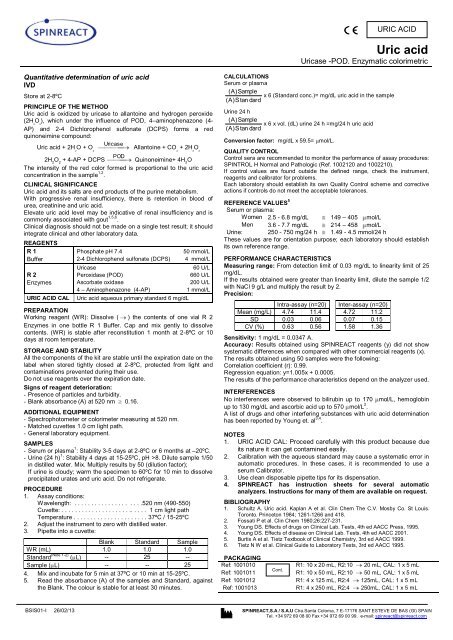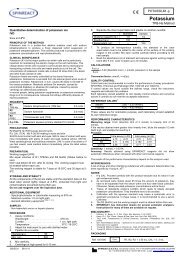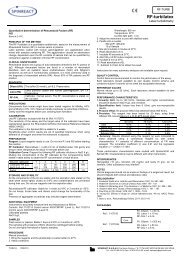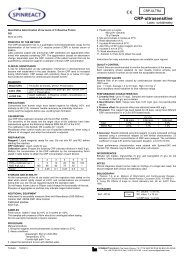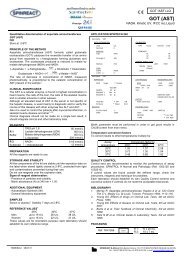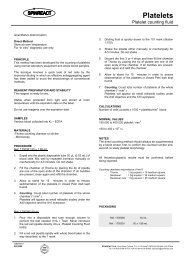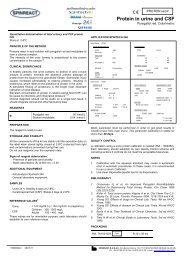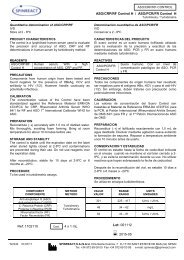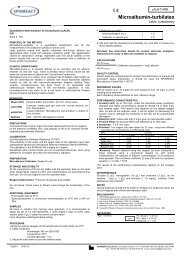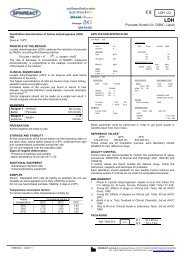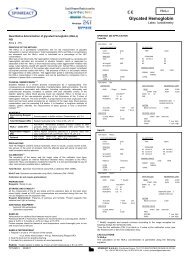Uric acid
Uric acid - Spinreact
Uric acid - Spinreact
Create successful ePaper yourself
Turn your PDF publications into a flip-book with our unique Google optimized e-Paper software.
URIC ACID<br />
<strong>Uric</strong> <strong>acid</strong><br />
<strong>Uric</strong>ase -POD. Enzymatic colorimetric<br />
Quantitative determination of uric <strong>acid</strong><br />
IVD<br />
Store at 2-8ºC<br />
PRINCIPLE OF THE METHOD<br />
<strong>Uric</strong> <strong>acid</strong> is oxidized by uricase to allantoine and hydrogen peroxide<br />
(2H<br />
2<br />
O<br />
2<br />
), which under the influence of POD, 4–aminophenazone (4-<br />
AP) and 2-4 Dichlorophenol sulfonate (DCPS) forms a red<br />
quinoneimine compound:<br />
<strong>Uric</strong>ase<br />
<strong>Uric</strong> <strong>acid</strong> + 2H<br />
2<br />
O + O<br />
2<br />
Allantoine + CO<br />
2<br />
+ 2H<br />
2<br />
O<br />
2<br />
POD<br />
2H 2<br />
O 2<br />
+ 4-AP + DCPS Quinoneimine+ 4H 2<br />
O<br />
The intensity of the red color formed is proportional to the uric <strong>acid</strong><br />
concentration in the sample 1,2 .<br />
CLINICAL SIGNIFICANCE<br />
<strong>Uric</strong> <strong>acid</strong> and its salts are end products of the purine metabolism.<br />
With progressive renal insufficiency, there is retention in blood of<br />
urea, creatinine and uric <strong>acid</strong>.<br />
Elevate uric <strong>acid</strong> level may be indicative of renal insufficiency and is<br />
commonly associated with gout 1,5,6 .<br />
Clinical diagnosis should not be made on a single test result; it should<br />
integrate clinical and other laboratory data.<br />
REAGENTS<br />
R 1<br />
Buffer<br />
R 2<br />
Enzymes<br />
URIC ACID CAL<br />
Phosphate pH 7.4<br />
2-4 Dichlorophenol sulfonate (DCPS)<br />
<strong>Uric</strong>ase<br />
Peroxidase (POD)<br />
Ascorbate oxidase<br />
4 – Aminophenazone (4-AP)<br />
<strong>Uric</strong> <strong>acid</strong> aqueous primary standard 6 mg/dL<br />
50 mmol/L<br />
4 mmol/L<br />
60 U/L<br />
660 U/L<br />
200 U/L<br />
1 mmol/L<br />
PREPARATION<br />
Working reagent (WR): Dissolve ( ) the contents of one vial R 2<br />
Enzymes in one bottle R 1 Buffer. Cap and mix gently to dissolve<br />
contents. (WR) is stable after reconstitution 1 month at 2-8ºC or 10<br />
days at room temperature.<br />
STORAGE AND STABILITY<br />
All the components of the kit are stable until the expiration date on the<br />
label when stored tightly closed at 2-8ºC, protected from light and<br />
contaminations prevented during their use.<br />
Do not use reagents over the expiration date.<br />
Signs of reagent deterioration:<br />
- Presence of particles and turbidity.<br />
- Blank absorbance (A) at 520 nm 0.16.<br />
ADDITIONAL EQUIPMENT<br />
- Spectrophotometer or colorimeter measuring at 520 nm.<br />
- Matched cuvettes 1.0 cm light path.<br />
- General laboratory equipment.<br />
SAMPLES<br />
- Serum or plasma 1 : Stability 3-5 days at 2-8ºC or 6 months at –20ºC.<br />
- Urine (24 h) 1 : Stability 4 days at 15-25ºC, pH >8. Dilute sample 1/50<br />
in distilled water. Mix. Multiply results by 50 (dilution factor);<br />
If urine is cloudy; warm the specimen to 60ºC for 10 min to dissolve<br />
precipitated urates and uric <strong>acid</strong>. Do not refrigerate.<br />
PROCEDURE<br />
1. Assay conditions:<br />
Wavelength: . . . . . . . . . . . . . . . . . . . .520 nm (490-550)<br />
Cuvette: . . . . . . . . . . . . . . . . . . . . .. . . . . 1 cm light path<br />
Temperature . . . . . . . . . . . . . . . . . . . . . . 37ºC / 15-25ºC<br />
2. Adjust the instrument to zero with distilled water.<br />
3. Pipette into a cuvette:<br />
Blank Standard Sample<br />
WR (mL) 1.0 1.0 1.0<br />
Standard (Note 1-2) ( L) -- 25 --<br />
Sample ( L) -- -- 25<br />
4. Mix and incubate for 5 min at 37ºC or 10 min at 15-25ºC.<br />
5. Read the absorbance (A) of the samples and Standard, against<br />
the Blank. The colour is stable for at least 30 minutes.<br />
CALCULATIONS<br />
Serum or plasma<br />
(A)Sample<br />
x 6 (Standard conc.)= mg/dL uric <strong>acid</strong> in the sample<br />
(A)Stan dard<br />
Urine 24 h<br />
(A)Sample<br />
x 6 x vol. (dL) urine 24 h =mg/24 h uric <strong>acid</strong><br />
(A)Stan dard<br />
Conversion factor: mg/dL x 59.5= mol/L.<br />
QUALITY CONTROL<br />
Control sera are recommended to monitor the performance of assay procedures:<br />
SPINTROL H Normal and Pathologic (Ref. 1002120 and 1002210).<br />
If control values are found outside the defined range, check the instrument,<br />
reagents and calibrator for problems.<br />
Each laboratory should establish its own Quality Control scheme and corrective<br />
actions if controls do not meet the acceptable tolerances.<br />
REFERENCE VALUES 5<br />
Serum or plasma:<br />
Women 2.5 - 6.8 mg/dL 149 – 405 mol/L<br />
Men 3.6 - 7.7 mg/dL 214 – 458 mol/L<br />
Urine: 250 - 750 mg/24 h 1.49 - 4.5 mmol/24 h<br />
These values are for orientation purpose; each laboratory should establish<br />
its own reference range.<br />
PERFORMANCE CHARACTERISTICS<br />
Measuring range: From detection limit of 0.03 mg/dL to linearity limit of 25<br />
mg/dL.<br />
If the results obtained were greater than linearity limit, dilute the sample 1/2<br />
with NaCl 9 g/L and multiply the result by 2.<br />
Precision:<br />
Intra-assay (n=20) Inter-assay (n=20)<br />
Mean (mg/L) 4.74 11.4 4.72 11.2<br />
SD 0.03 0.06 0.07 0.15<br />
CV (%) 0.63 0.56 1.58 1.36<br />
Sensitivity: 1 mg/dL = 0.0347 A.<br />
Accuracy: Results obtained using SPINREACT reagents (y) did not show<br />
systematic differences when compared with other commercial reagents (x).<br />
The results obtained using 50 samples were the following:<br />
Correlation coefficient (r): 0.99.<br />
Regression equation: y=1.005x + 0.0005.<br />
The results of the performance characteristics depend on the analyzer used.<br />
INTERFERENCES<br />
No interferences were observed to bilirubin up to 170 mol/L, hemoglobin<br />
up to 130 mg/dL and ascorbic <strong>acid</strong> up to 570 mol/L 2 .<br />
A list of drugs and other interfering substances with uric <strong>acid</strong> determination<br />
has been reported by Young et. al 3,4 .<br />
NOTES<br />
1. URIC ACID CAL: Proceed carefully with this product because due<br />
its nature it can get contamined easily.<br />
2. Calibration with the aqueous standard may cause a systematic error in<br />
automatic procedures. In these cases, it is recommended to use a<br />
serum Calibrator.<br />
3. Use clean disposable pipette tips for its dispensation.<br />
4. SPINREACT has instruction sheets for several automatic<br />
analyzers. Instructions for many of them are available on request.<br />
BIBLIOGRAPHY<br />
1. Schultz A. <strong>Uric</strong> <strong>acid</strong>. Kaplan A et al. Clin Chem The C.V. Mosby Co. St Louis.<br />
Toronto. Princeton 1984; 1261-1266 and 418.<br />
2. Fossati P et al. Clin Chem 1980;26:227-231.<br />
3. Young DS. Effects of drugs on Clinical Lab. Tests, 4th ed AACC Press, 1995.<br />
4. Young DS. Effects of disease on Clinical Lab. Tests, 4th ed AACC 2001.<br />
5. Burtis A et al. Tietz Textbook of Clinical Chemistry, 3rd ed AACC 1999.<br />
6. Tietz N W et al. Clinical Guide to Laboratory Tests, 3rd ed AACC 1995.<br />
PACKAGING<br />
Ref: 1001010 R1: 10 x 20 mL, R2:10 20 mL, CAL: 1 x 5 mL<br />
Ref: 1001011<br />
Cont.<br />
. R1: 10 x 50 mL, R2:10 50 mL, CAL: 1 x 5 mL<br />
Ref: 1001012 R1: 4 x 125 mL, R2:4 125mL, CAL: 1 x 5 mL<br />
Ref: 1001013 R1: 4 x 250 mL, R2:4 250mL, CAL: 1 x 5 mL<br />
BSIS01-I 26/02/13 SPINREACT,S.A / S.A.U Ctra.Santa Coloma, 7 E-17176 SANT ESTEVE DE BAS (GI) SPAIN<br />
Tel. +34 972 69 08 00 Fax +34 972 69 00 99. e-mail: spinreact@spinreact.com
Determinación cuantitativa de ácido úrico<br />
IVD<br />
Conservar a 2-8ºC<br />
PRINCIPIO DEL MÉTODO<br />
El ácido úrico es oxidado por la uricasa a alantoína y peróxido de<br />
hidrógeno (2H 2O 2) que en presencia de peroxidasa (POD), 4-<br />
aminofenazona (4-AF) y 2-4 Diclorofenol Sulfonato (DCPS) forma un<br />
compuesto rosáceo:<br />
<strong>Uric</strong>asa<br />
Ácido úrico + 2H 2<br />
O + O 2<br />
Alantoína + CO 2<br />
+ 2H 2<br />
O 2<br />
POD<br />
2H 2<br />
O 2<br />
+ 4-AF + DCPS Quinonaimina + 4H 2<br />
O<br />
La intensidad de quinonaimina roja formada es proporcional a la<br />
concentración de ácido úrico presente en la muestra ensayada 1,2 .<br />
SIGNIFICADO CLÍNICO<br />
El ácido úrico y sus sales son el producto final del metabolismo de las<br />
purinas. En una insuficiencia renal progresiva hay una retención en<br />
sangre de urea, creatinina y ácido úrico.<br />
Niveles altos de ácido úrico son indicativos de patología renal y<br />
generalmente se asocia con la gota 1,5,6 .<br />
El diagnóstico clínico debe realizarse teniendo en cuenta todos los<br />
datos clínicos y de laboratorio.<br />
REACTIVOS<br />
R 1<br />
Tampón<br />
R 2<br />
Enzimas<br />
URIC ACID CAL<br />
Fosfatos pH 7,4<br />
2-4 Diclorofenol Sulfonato (DCPS)<br />
<strong>Uric</strong>asa<br />
Peroxidasa (POD)<br />
Ascorbato oxidasa<br />
4 - Aminofenazona (4-AF)<br />
50 mmol/L<br />
4 mmol/L<br />
60 U/L<br />
660 U/L<br />
200 U/L<br />
1 mmol/L<br />
Patrón primario acuoso de Ácido úrico 6 mg/dL<br />
PREPARACIÓN<br />
Reactivo de trabajo (RT): Disolver ( ) el contenido de un vial de R 2<br />
Enzimas en un frasco de R 1 Tampón. Tapar y mezclar suavemente<br />
hasta disolver su contenido. Estabilidad: 1 mes en nevera (2-8ºC) o<br />
10 días a temperatura ambiente.<br />
CONSERVACIÓN Y ESTABILIDAD<br />
Todos los componentes del kit son estables, hasta la fecha de<br />
caducidad indicada en la etiqueta, cuando se mantienen los frascos<br />
bien cerrados a 2-8ºC, protegidos de la luz y se evita su<br />
contaminación. No usar reactivos fuera de la fecha indicada.<br />
Indicadores de deterioro de los reactivos:<br />
- Presencia de partículas y turbidez.<br />
- Absorbancia (A) del Blanco a 520 nm 0,16.<br />
MATERIAL ADICIONAL<br />
- Espectrofotómetro o analizador para lecturas a 520 nm.<br />
- Cubetas de 1,0 cm de paso de luz.<br />
- Equipamiento habitual de laboratorio.<br />
MUESTRAS<br />
- Suero o plasma 1 : Estabilidad 3-5 días a 2-8ºC y 6 meses a –20ºC.<br />
- Orina (24 h) 1 : Estabilidad 3 días a temperatura ambiente a pH > 8.<br />
Diluir la muestra al 1/50 en agua destilada. Mezclar. Multiplicar el<br />
resultado obtenido por 50 (factor de dilución); Si la muestra es<br />
turbia, calentarla a 60ºC 10 min para disolver los precipitados de<br />
urato y ácido úrico. No refrigerar.<br />
PROCEDIMIENTO<br />
1. Condiciones del ensayo:<br />
Longitud de onda: . . . . . . . . . . . . . . . .520 nm (490-550)<br />
Cubeta:. . . . . . . . . . . . . . . . . . . . . . . .. .1 cm paso de luz<br />
Temperatura . . . . . . . . . . . . . . . . . . . . . . . 37ºC / 15-25ºC<br />
2. Ajustar el espectrofotómetro a cero frente a agua destilada.<br />
3. Pipetear en una cubeta:<br />
Blanco Patrón Muestra<br />
RT (mL) 1,0 1,0 1,0<br />
Patrón (Nota1-2) ( L) -- 25 --<br />
Muestra ( L) -- -- 25<br />
4. Mezclar e incubar 5 minutos a 37ºC ó 10 min. 15-25ºC.<br />
5. Leer la absorbancia (A) del Patrón y la muestra, frente al<br />
Blanco de reactivo. El color es estable como mínimo 30<br />
minutos.<br />
URIC ACID<br />
Ácido úrico<br />
<strong>Uric</strong>asa -POD. Enzimático colorimétrico<br />
CÁLCULOS<br />
Suero o plasma<br />
(A)Muestra<br />
x 6 (Conc. Patrón) = mg/dL de ácido úrico en la muestra<br />
(A)Patrón<br />
Orina 24 h<br />
(A)Muestra<br />
x 6 x vol. (dL) orina/24h = mg/24 h de ácido úrico<br />
(A)Patrón<br />
Factor de conversión: mg/dL x 59,5= mol/L.<br />
CONTROL DE CALIDAD<br />
Es conveniente analizar junto con las muestras sueros control valorados:<br />
SPINTROL H Normal y Patológico (Ref. 1002120 y 1002210).<br />
Si los valores hallados se encuentran fuera del rango de tolerancia, revisar<br />
el instrumento, los reactivos y el calibrador.<br />
Cada laboratorio debe disponer su propio Control de Calidad y establecer<br />
correcciones en el caso de que los controles no cumplan con las<br />
tolerancias.<br />
VALORES DE REFERENCIA 5<br />
Suero o plasma:<br />
Mujeres 2,5 - 6,8 mg/dL 149 – 405 mol/L<br />
Hombres 3,6 - 7,7 mg/dL 214 – 458 mol/L<br />
Orina: 250 - 750 mg/24 h 1,49 - 4,5 mmol/24 h<br />
Estos valores son orientativos. Es recomendable que cada laboratorio<br />
establezca sus propios valores de referencia.<br />
CARACTERÍSTICAS DEL MÉTODO<br />
Rango de medida: Desde el límite de detección de 0,03 mg/dL hasta el<br />
límite de linealidad de 25 mg/dL.<br />
Si la concentración es superior al límite de linealidad, diluir la muestra 1/2<br />
con ClNa 9 g/L y multiplicar el resultado final por 2.<br />
Precisión:<br />
Intraserie (n= 20) Interserie (n= 20)<br />
Media (mg/L) 4,74 11,4 4,72 11,2<br />
SD 0,03 0,06 0,07 0,15<br />
CV (%) 0,63 0,56 1,58 1,36<br />
Sensibilidad analítica: 1 mg/dL = 0,0347 A.<br />
Exactitud: Los reactivos SPINREACT (y) no muestran diferencias<br />
sistemáticas significativas cuando se comparan con otros reactivos<br />
comerciales (x).<br />
Los resultados obtenidos con 50 muestras fueron los siguientes:<br />
Coeficiente de correlación (r): 0,99.<br />
Ecuación de la recta de regresión: y=1,005x + 0,0005.<br />
Las características del método pueden variar según el analizador utilizado.<br />
INTERFERENCIAS<br />
No se han observado interferencias con bilirrubina hasta 170 mol/L,<br />
hemoglobina hasta 130 mg/dL y ácido ascórbico hasta 570 mol/L 2 .<br />
Se han descrito varias drogas y otras substancias que interfieren en la<br />
determinación del ácido úrico 3,4 .<br />
NOTAS<br />
1. URIC ACID CAL: Debido a la naturaleza del producto, es aconsejable<br />
tratarlo con sumo cuidado ya que se puede contaminar con facilidad.<br />
2. La calibración con el Patrón acuoso puede dar lugar a errores<br />
sistemáticos en métodos automáticos. En este caso, se recomienda<br />
utilizar calibradores séricos.<br />
3. Usar puntas de pipeta desechables limpias para su dispensación.<br />
4. SPINREACT dispone de instrucciones detalladas para la aplicación<br />
de este reactivo en distintos analizadores.<br />
BIBLIOGRAFÍA<br />
1. Schultz A. <strong>Uric</strong> <strong>acid</strong>. Kaplan A et al. Clin Chem The C.V. Mosby Co. St Louis. Toronto.<br />
Princeton 1984; 1261-1266 and 418.<br />
2. Fossati P et al. Clin Chem 1980;26:227-231.<br />
3. Young DS. Effects of drugs on Clinical Lab. Tests, 4th ed AACC Press, 1995.<br />
4. Young DS. Effects of disease on Clinical Lab. Tests, 4th ed AACC 2001.<br />
5. Burtis A et al. Tietz Textbook of Clinical Chemistry, 3rd ed AACC 1999.<br />
6. Tietz N W et al. Clinical Guide to Laboratory Tests, 3rd ed AACC 1995.<br />
PRESENTACIÓN<br />
Ref: 1001010 R1: 10 x 20 mL, R2:10 20 mL, CAL: 1 x 5 mL<br />
Ref: 1001011<br />
Cont.<br />
. R1: 10 x 50 mL, R2:10 50 mL, CAL: 1 x 5 mL<br />
Ref: 1001012 R1: 4 x 125 mL, R2:4 125mL, CAL: 1 x 5 mL<br />
Ref: 1001013 R1: 4 x 250 mL, R2:4 250mL, CAL: 1 x 5 mL<br />
BSIS01-E 26/02/13 SPINREACT, S.A / S.A.U Ctra.Santa Coloma, 7 E-17176 SANT ESTEVE DE BAS (GI) SPAIN<br />
Tel. +34 972 69 08 00 Fax +34 972 69 00 99. e-mail: spinreact@spinreact.com


